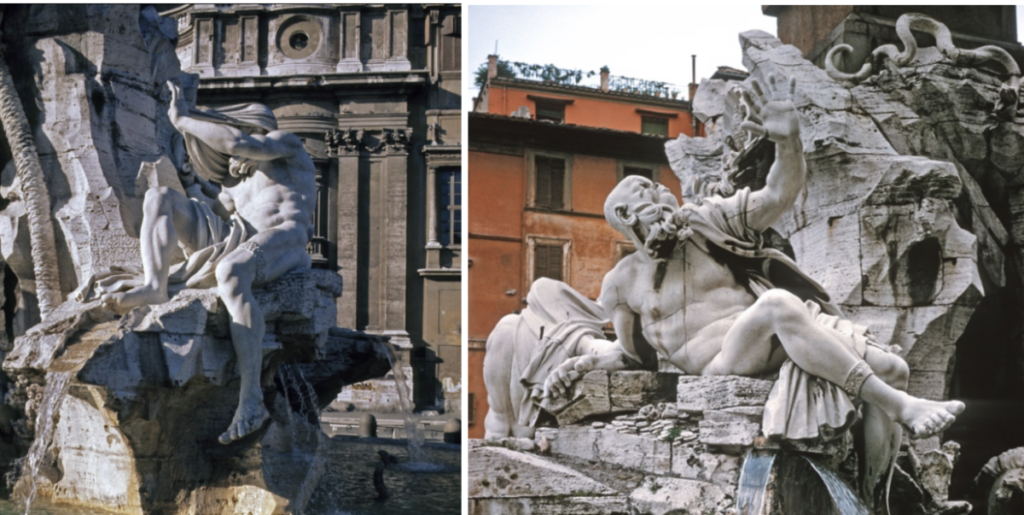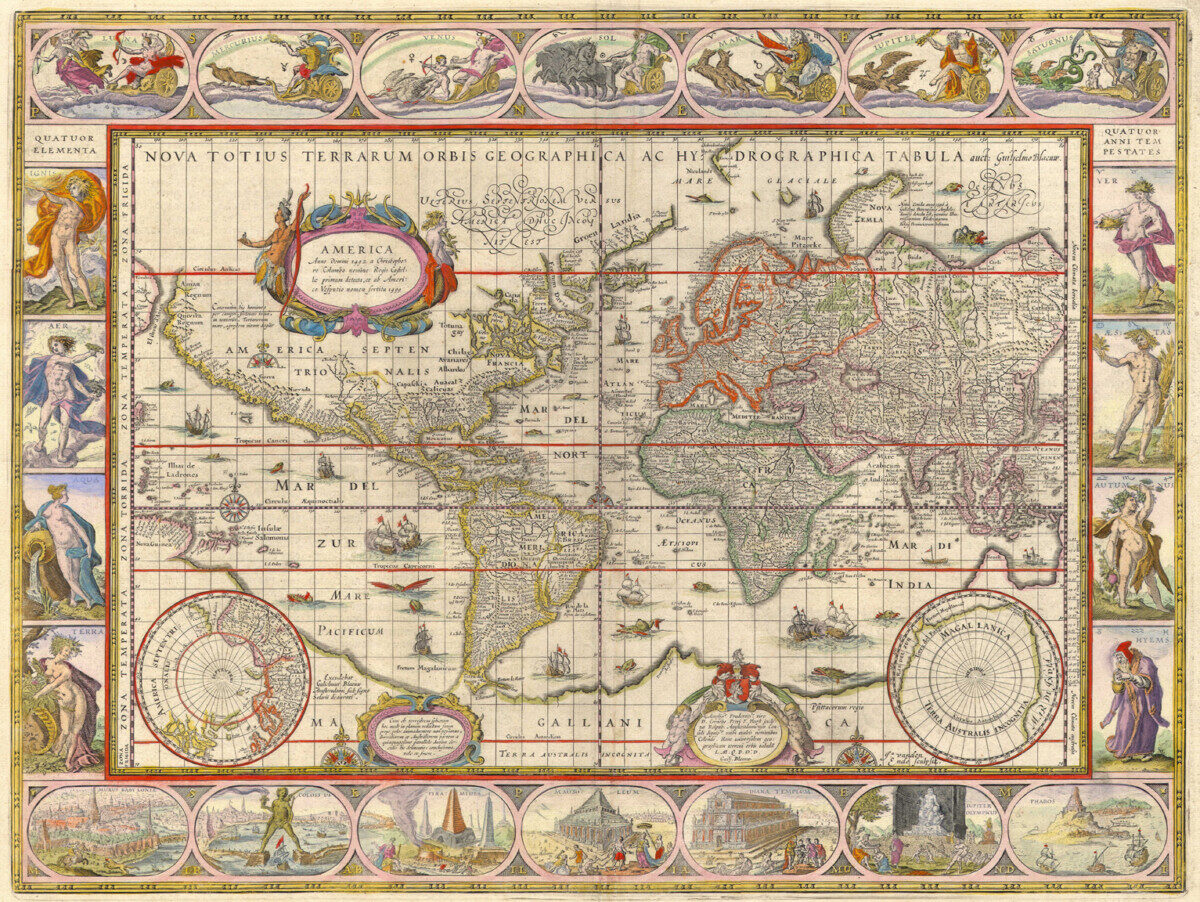The Oxford English Dictionary defines Baroque as “irregularly shaped; whimsical, grotesque, odd….” When applied to art, this adjective suddenly becomes a highly diverse entity that encompasses a vast amount of artworks all around the globe. These artworks take on many different forms, from painting to sculpture to pottery, and each has respective artists who bring their baroque art to life. One of the most well-known of these artists is Gian Lorenzo Bernini, an Italian sculptor known as the maker of Baroque Rome due to his contribution of spectacular fountains, architecture, urban planning, and more. One of these fountains, particularly the Four Rivers Fountain, embodies the baroque style that Bernini was so famous for. Located in the Piazza Navona in Rome, the fountain demands attention due to its large obelisk and four giant statues of river gods that give the water feature its name. The incorporation of these statues and their representations alludes to a global exchange at the time. Bernini’s Four Rivers Fountain highlights global exchange in the early modern period through the representation of global ideas, symbolism in sculpture, and the materials used throughout the work.
Visually, it is apparent that there is an allusion to global exchange due to the decorative sculpture that comprises the fountain’s base. When circling the fountain, four prominent figures are depicted, each in motion yet posing very differently. Each statue represents one of the four great rivers of the world: the Ganges, Nile, Rio de la Plata, and the Danube. Additionally, these rivers are each located on a different continent to connect Bernini’s Four Rivers Fountain to the rest of the world despite being in an Italian Piazza. Furthermore, the sculptural decoration surrounding each figure aids in understanding which part of the globe is referenced. The Danube River God (see Fig.1) is depicted next to a horse and in front of citrons representing Europe. To the right of the Danube is the Ganges River God (see Fig. 2), holding an oar that goes into the water right next to a dragon representing Asia.

Source: Artstor, library-artstor-org.proxy.library.emory.edu/asset/SS35507 Source: Photographer: Vickery, Robert L. Artstor,
_35507_20815846 library-artstor-org.proxy.library.emory.edu/asset/SS7731616_7731616_12715154
Moving counterclockwise around the fountain, the Nile River God (see Fig. 3) is seen beside a large palm tree and lion to encompass the continent of Africa. Finally, the last river god, Rio de la Plata (see Fig. 4), completes the circular path around the fountain and is shown above an armadillo and beside a prickly pear to represent the Americas. These four river gods and their respective sculptural decorations allow spectators to connect the fountain to global exchange.

Source: Fancelli, Giacomo Antonio, Artstor, library-artstor-org.proxy.l Source: Baratta, Francesco, Artstor,
ibrary.emory.edu/asset/APINTOIG_10313946737. library-artstor-org.proxy.library.emory.edu/asset/AMCDONALDIG_10313949773
Towering over the decorated base of the Four Rivers Fountain is a 115-foot-high Egyptian obelisk (see Fig. 5) that separates water from the sky. It is set apart from the travertine base with its dry granite composition that gives it a darker color and juxtaposes the white water-covered base. Broken initially into five pieces in the Circus of Maxentius, the obelisk was reconstructed by Bernini into the seamless granite slab that still stands today. Lines of hieroglyphs are carved into the obelisk to pay tribute to the Roman emperor Domitian to whom it was originally dedicated (see Fig. 6). Interestingly, these hieroglyphs appear to have been “Romanized,” as Athanasius Kircher, the scholar who translated them, wrote in his analysis of the translations. Therefore, this “Romanization” shows a unique relationship between Rome and Egypt, with the great Roman Empire borrowing elements from Egyptian culture.

Source: Artstor, library-artstor-org.proxy.library.emory.edu/asset/ASITESPHOTOIG Source: Artstor, library-artstor-org.proxy.library.emory.edu/asset/ASITESPHOTOIG_10312730540
_10312730548
This appropriation of Egyptian culture is even more apparent when looking at the very top of the obelisk, where there is a carved dove and olive branch, which symbolize peace, the Holy Spirit, and the Pamphili family who commissioned the fountain. This use of an obelisk to symbolize divinity is similar to Egyptian obelisks being created for their sun God Ra. The tall, pointed shape was meant to embody a sun ray to represent the divine light of Ra. Although the obelisk of the fountain is not Egyptian in origin, it borrows from Egyptian culture with its shape and the hieroglyphs inscribed into it. Overall, there is a reference to global exchange between Egypt and Italy, with the obelisk’s symbolic light tying the two nations together. Additionally, when considering the obelisk of the Four Rivers Fountain as a source of divine light, an exciting element in ideas of global exchange is seen due to the river gods’ reaction to it. Each figure strikes a different pose to convey their respective continent’s reaction to Catholicism, which the obelisk subtly represents.
The Nile River God sits with one knee up and the other hanging over an edge while he leans back on his right hand. His face is not visible due to the cloth he holds over his head, shielding his eyes so that only his long curly beard is visible. Given that the Nile River God represents Africa, holding the cloth over his eyes symbolizes Africa’s rejection of Catholicism at the time. Conversely, the Rio de la Plata River God opposes the Nile River God in position and pose. He embraces the divine light of the obelisk with one hand raised toward it and his head turned upward. While his face is challenging to see, his curly beard is visible in stark contrast to his bald head. Under the same theme of the obelisk symbolizing Catholicism, the Rio de la Plata fully embraces it. Therefore, the Americas and Africa are juxtaposed in their reactions to this new religion which is reflected in their orientation toward the obelisk.
The Ganges River God is the only figure to acknowledge viewers of the fountain as he stares out stoically while posing in a semi-reclined position. He leans back on one arm while the other holds an oar pierced into the water below him. Although his body aligns with the rocky surface upon which he sits, he turns his neck outward as though something from the outside world catches his attention. This ignorance of the obelisk falls somewhere between Rio de la Plata’s wholehearted acceptance and the Nile’s rejection. Instead, it seems the Ganges is ignoring it by turning away and facing spectators instead, which represents Asia’s ignorance of Catholicism. Lastly, the Danube River God twists so that his back faces the outside world while he acknowledges the divine light of the obelisk yet is not blinded by it as the Rio de la Plata River God is. He appears to lean backward, almost falling into the water, with one hand outstretched and the other touching the sculpture of the papal arms above him (see Fig. 7). The Danube, therefore, symbolizes an acceptance of the papal government at the time and the acknowledgment of Catholicism in Europe.

Although the four giant statues of the river gods at the base of the Four Rivers Fountain demand attention, many other sculptures deserve similar recognition for their symbolization of global exchange. One of the most prominent symbols is the depiction of tiny coins that pile upon each other on the rock next to the Rio de la Plata River God. These were carved to represent the silver coins found within the Rio de la Plata River in South America; silver was so abundant here that it sometimes was referred to as the River of Silver. Therefore, in the act of global exchange, the Americas were associated with the trade of silver due to its abundance in the Rio de la Plata. Similarly, the Nile River God sits next to a large palm tree that makes its way up the fountain’s base. This inclusion portrays the association of palm oil, harvested from palm trees, to the African continent that the Nile River God represents. These references to global materials and trade secure the fountain’s place in representing global exchange.
While there are many different ways that global exchange was referenced within Gian Lorenzo Bernini’s Four Rivers Fountain, it is most apparent in the use of sculpture, the highlighting of materials, and the symbolism of religious acceptance. This was done using the baroque style, which aided in the globalization of this artwork— incorporating four river god statues and their respective unique symbols to refer viewers to four continents aided in understanding global exchange. The allusion to globally traded materials was reinforced with the Rio de la Plata River God’s silver coins and the Nile River God’s position next to an African palm tree. Then, the differing reactions to Catholicism were depicted through the positions of statues, such as the cloak shielding the eyes of the Nile River God and the Rio de la Plata’s total embracing of divinity. Lastly, with its Romanized hieroglyphs, the Egyptian obelisk portrayed a unique relationship between Italy and Egypt that solidified the Four Rivers Fountain’s place in global art history.
Works Cited
Avery, Charles. Bernini: Genius of the Baroque. Thames & Hudson, 2006.
“Baroque, adj. and n.” Oxford English Dictionary Online, Oxford University Press, March 2023, www.oed.com/view/Entry/15685. Accessed 20 April 2023.
Caneva, G., Altieri, A., Kumbaric, A. et al. Plant iconography and its message: realism and symbolic message in the Bernini fountain of the four rivers in Rome. Rend. Fis. Acc. Lincei 31, 1011–1026 (2020). https://doi.org/10.1007/s12210-020-00946-2
Christian, Mary. “Bernini’s ‘Danube’ and Pamphili Politics.” The Burlington Magazine, vol. 128, no. 998, 1986, pp. 354–352. JSTOR, http://www.jstor.org/stable/882496. Accessed 24 Apr. 2023.
Dickerson, C. D., et al. Bernini, Sculpting in Clay. The Metropolitan Museum of Art, 2012.
Fehrenback, Frank. “Impossibile: Bernini in Piazza Navona.” RES: Anthropology and Aesthetics, no. 63/64, 2013, pp. 229–37. JSTOR, http://www.jstor.org/stable/23647766. Accessed 24 Apr. 2023.
Rowland, Ingrid. “‘Th’ United Sense of Th’ Universe’: Athanasius Kircher in Piazza Navona.” Memoirs of the American Academy in Rome, vol. 46, 2001, pp. 153–81. JSTOR, https://doi.org/10.2307/4238784. Accessed 24 Apr. 2023.
San Juan, Rose Marie. “The Transformation of the Río de La Plata and Bernini’s Fountain of the Four Rivers in Rome.” Representations, vol. 118, no. 1, 2012, pp. 72–102. JSTOR, https://doi.org/10.1525/rep.2012.118.1.72. Accessed 24 Apr. 2023.
